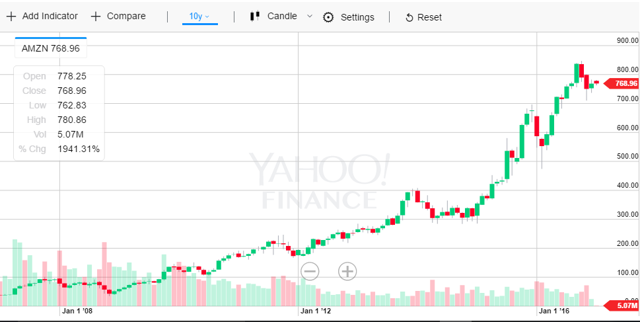Fundamentals aren’t enough for AMZN stock, one needs to look beyond them.
– Amazon.com, Inc. (NASDAQ:AMZN), Inc’s fundamentals are a mixed bag.
– Market structure dictates that the stock cannot exponentially increase forever.
– You need to figure out who is in control to make the best out of your investment.
Remember the $1000 Amazon.com, Inc. (NASDAQ:AMZN) price target many were cackling and crowing about? Well, that enthusiasm has quelled down a bit and for good reason. Fundamentally, AMZN stock does not make sense. However, understanding market structure can help you overcome this hurdle. Let’s take a closer look to figure out how should you go about your investment in AMZN stock.
Fundamentals
One trader who has been active in the markets for over 40 years, James Dalton, has a unique view of the markets. According to him, fundamentals are okay but you are out of touch with the markets if you solely depend on the numbers. Context and time-frame mean everything.
When I look at the basic fundamental ratios of Amazon, something does not click. Using basic fundamental ratios, we can reverse engineer what the current earnings and sales should be based on the simple PE and PS ratio. At the time of writing this article, the current trailing PE ratio was 175.68. When I divide 1000 by 175.68, it gives me an earnings per share of $5.69. Amazon’s current trailing earnings are close to the number at $4.36. However, there is something fishy with the PE ratio when you go a bit deeper from surface-level comprehension. The 175.68 number theoretically represents you, the investor, paying 175.68 dollars for 1 dollar of earnings per year. It will take close to two centuries to get back your investment meaning you are not wise enough if you are giving your hard earned money to Amazon.
The PS ratio is currently at 2.89. $1000 divided by 2.89 is $346.02 of sales per share. Amazon is currently sitting at approximately $271 of sales per share. While Amazon’s price target may be justified in terms of sales, investors are conditioned to think in terms of earnings. Due to the lofty PE ratio, Amazon is a risky investment.
Also Read: AMZN Stock: Why Amazon.com Inc’s Disruption Phase Is Over Now
Thus, fundamentally the stock seems to be mixed. However, this is where analysts seem to conveniently focus on revenues to recommend a buy. It is the only justification they can give in order to be a part of the Amazon herd. This you can relate to the social identity theory (1). It does not matter how wrong they are as long as they have company. I know some of you are probably thinking that I did not look at the future of Amazon, its market share, or didn’t even make a growth assumption. These are good ideas. However, studies have shown that analysts fail to acknowledge that their models are breakable (2) due to over-familiarity. Additionally, I believe that it is the top management team’s responsibility to figure those factors out.
This is where I believe the concept of the market structure comes in handy.
Market Structure
Stocks do not fly upwards for an extended period of time. It is normally a slow crawl upwards. Below is a chart of Amazon.com, Inc. (NASDAQ:AMZN). From the end of 2014 to the end of 2016, Amazon shot upwards. A prolonged upward trend is not sustainable. A typical stock moves in a tight range before having the short volatile breakout. The market participants determine directionally where Amazon could be headed next.
(Source: Yahoo Finance)
Follow Amazon Com Inc (NASDAQ:AMZN)
Follow Amazon Com Inc (NASDAQ:AMZN)
Receive real-time insider trading and news alerts
There are three categories of market participants: short-term, medium-term, and long-term. You need to figure out who is in control which requires a deep understanding of the markets. According to auction theory, there is a distinct behavior of these three groups. (See Also: AMZN Stock: 3 Reasons Why Investors Should Buy This Dip In Amazon.com Inc. Stock)
We are all familiar with the saying ‘for every buyer there is a seller’. Unfortunately, that is a necessary but insufficient condition. The buying and selling are intermingled among these three groups. If the stock movement seems mechanical, short-term traders are in control. Previous day highs and lows, yesterday’s close, etc. are all mechanical points. These traders want to stay within the range. The medium-term traders are the hedge funds that come in when the stock has a significant pullback and push the stock high but do not try to break the huge trading range (Think Ackman and Chipotle Mexican Grill, Inc. (NYSE:CMG)). The long-term traders are who you need to be able to identify. If the stock goes to new highs, these traders are in control.
Your goal should be to participate in, and not anticipate what Amazon.com, Inc. (NASDAQ:AMZN) may do next. Your goal is to determine what type of trader/investor you are. Knowing yourself can help you understand the actions of other market participants as the days unfold.
Conclusion
An understanding of market structure is more beneficial than static fundamental models. There is always some conflicting information in fundamentals, but market structure can help alleviate that paradox.
Looking for great tech stocks to buy? Check out Amigobulls’ top stock picks (3), which have beaten the NASDAQ by over 112%.
The article Are Fundamentals Really Driving Amazon.com, Inc. (AMZN) Stock Higher? originally appeared on amigobulls.com. Watch our analysis video on AMZN
Amigobulls.com – Watch, Analyze, Invest. Why spend hours putting together numbers you can get in minutes, in one simple video? Our ‘Robo Advisor’ videos give you every number that matters, in 1 minute. Find insightful articles with ideas on investing, top stock picks that outperform the markets, personalized portfolio analysis videos and a whole lot more. Amigobulls.com – Your Friend On Wall Street.
Additional Links:
(1) http://www.simplypsychology.org/social-identity-theory.html?ref=il
(2) http://pubsonline.informs.org/doi/abs/10.1287/orsc.1080.0395?ref=il
(3) http://amigobulls.com/stocks-to-buy/top-tech-stocks/?ref=il&ref=im






